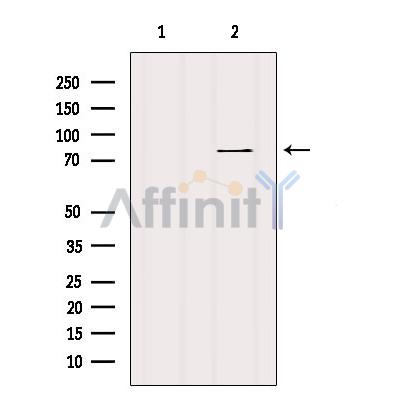HRP2 Antibody - #DF12282
| Product: | HRP2 Antibody |
| Catalog: | DF12282 |
| Description: | Rabbit polyclonal antibody to HRP2 |
| Application: | WB IHC |
| Reactivity: | Human, Mouse, Rat, Monkey |
| Prediction: | Pig, Sheep, Dog, Xenopus |
| Mol.Wt.: | 74 kDa; 74kD(Calculated). |
| Uniprot: | Q7Z4V5 |
| RRID: | AB_2845087 |
Related Downloads
Protocols
Product Info
*The optimal dilutions should be determined by the end user. For optimal experimental results, antibody reuse is not recommended.
*Tips:
WB: For western blot detection of denatured protein samples. IHC: For immunohistochemical detection of paraffin sections (IHC-p) or frozen sections (IHC-f) of tissue samples. IF/ICC: For immunofluorescence detection of cell samples. ELISA(peptide): For ELISA detection of antigenic peptide.
Cite Format: Affinity Biosciences Cat# DF12282, RRID:AB_2845087.
Fold/Unfold
HDGF-2; HDGF2; Hdgfrp2; HDGR2_HUMAN; Hepatoma-derived growth factor 2; Hepatoma-derived growth factor; Hepatoma-derived growth factor-related protein 2; heptoma derived growth factor related protein 2; HRP-2;
Immunogens
A synthesized peptide derived from human HRP2, corresponding to a region within N-terminal amino acids.
Widely expressed. High expression is found in heart, skeletal muscle, ovary and testis. Overexpression is frequently observed in hepatocellular carcinoma samples.
- Q7Z4V5 HDGR2_HUMAN:
- Protein BLAST With
- NCBI/
- ExPASy/
- Uniprot
MPHAFKPGDLVFAKMKGYPHWPARIDDIADGAVKPPPNKYPIFFFGTHETAFLGPKDLFPYDKCKDKYGKPNKRKGFNEGLWEIQNNPHASYSAPPPVSSSDSEAPEANPADGSDADEDDEDRGVMAVTAVTATAASDRMESDSDSDKSSDNSGLKRKTPALKMSVSKRARKASSDLDQASVSPSEEENSESSSESEKTSDQDFTPEKKAAVRAPRRGPLGGRKKKKAPSASDSDSKADSDGAKPEPVAMARSASSSSSSSSSSDSDVSVKKPPRGRKPAEKPLPKPRGRKPKPERPPSSSSSDSDSDEVDRISEWKRRDEARRRELEARRRREQEEELRRLREQEKEEKERRRERADRGEAERGSGGSSGDELREDDEPVKKRGRKGRGRGPPSSSDSEPEAELEREAKKSAKKPQSSSTEPARKPGQKEKRVRPEEKQQAKPVKVERTRKRSEGFSMDRKVEKKKEPSVEEKLQKLHSEIKFALKVDSPDVKRCLNALEELGTLQVTSQILQKNTDVVATLKKIRRYKANKDVMEKAAEVYTRLKSRVLGPKIEAVQKVNKAGMEKEKAEEKLAGEELAGEEAPQEKAEDKPSTDLSAPVNGEATSQKGESAEDKEHEEGRDSEEGPRCGSSEDLHDSVREGPDLDRPGSDRQERERARGDSEALDEES
Predictions
Score>80(red) has high confidence and is suggested to be used for WB detection. *The prediction model is mainly based on the alignment of immunogen sequences, the results are for reference only, not as the basis of quality assurance.
High(score>80) Medium(80>score>50) Low(score<50) No confidence
Research Backgrounds
Involved in cellular growth control, through the regulation of cyclin D1 expression.
Nucleus.
Widely expressed. High expression is found in heart, skeletal muscle, ovary and testis. Overexpression is frequently observed in hepatocellular carcinoma samples.
Belongs to the HDGF family.
Restrictive clause
Affinity Biosciences tests all products strictly. Citations are provided as a resource for additional applications that have not been validated by Affinity Biosciences. Please choose the appropriate format for each application and consult Materials and Methods sections for additional details about the use of any product in these publications.
For Research Use Only.
Not for use in diagnostic or therapeutic procedures. Not for resale. Not for distribution without written consent. Affinity Biosciences will not be held responsible for patent infringement or other violations that may occur with the use of our products. Affinity Biosciences, Affinity Biosciences Logo and all other trademarks are the property of Affinity Biosciences LTD.




